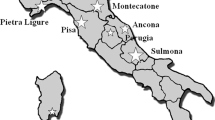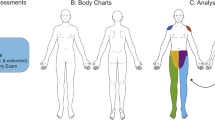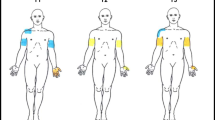Abstract
Objectives:
The aim of the study was to evaluate the characteristics of neuropathic pain and observe intensity alterations in pain with regard to time during the day in spinal cord injury (SCI) patients.
Methods:
A total of 50 SCI patients (M/F, 40/10; mean age, 35±12 years) with at-level and below-level neuropathic pain were included in the study. All patients were examined and classified according to the ASIA/ISCoS 2002 International Neurologic Examination and Classification Standards. The history, duration, localization and characteristics of the pain were recorded. Neuropathic pain of patients was evaluated with the McGill-Melzack Pain Questionnaire and LANSS (Leeds Assessment of Neuropathic Symptoms and Signs) Pain Scale. Visual analog scale (VAS) was used to measure the severity of pain four times during the day. Quality of life was analyzed with Short Form 36.
Results:
Out of 50 patients, 10 were tetraplegic and 40 were paraplegic. In all, 28 patients had motor and sensory complete injuries (AIS A), whereas 22 patients had sensory incomplete (AIS B, C and D) injuries. The most frequently used words to describe neuropathic pain were throbbing, tiring, hot and tingling. Pain intensity was significantly higher in the night than in the evening, noon and morning (P<0.05) (VAS morning: 5.16±2.42, VAS noon: 5.24±2.52, VAS evening: 5.80±2.46 and VAS night: 6.38±2.19).
Conclusion:
Neuropathic pain is a serious complaint in SCI patients and affects their quality of life. Neuropathic pain intensity was higher in the night hours than other times of day. This situation reinforces the need for a continued research and education on neuropathic pain in SCI.
Similar content being viewed by others
Log in or create a free account to read this content
Gain free access to this article, as well as selected content from this journal and more on nature.com
or
References
Calmels P, Mick G, Perrouin-Verde B, Ventura M . Neuropathic pain in spinal cord injury: identification, classification, evaluation. Ann Phys Rehabil Med 2009; 52: 83–102.
To TP, Lim TC, Hill ST, Frauman AG, Cooper N, Kirsa SW et al. Gabapentin for neuropathic pain following spinal cord injury. Spinal Cord 2002; 40: 282–285.
Budh NC, Lund I, Hultling C, Levi R, Werhagen L, Ertzgaard P et al. Gender related differences in pain in spinal cord injured individuals. Spinal Cord 2003; 41: 122–128.
Finnerup NB, Johannesen IL, Sindrup SH, Bach FW, Jensen TS . Pain and dysesthesia in patients with spinal cord injury: a postal survey. Spinal Cord 2001; 39: 256–262.
Siddall PJ . Management of neuropathic pain following spinal cord injury: now and in the future. Spinal Cord 2009; 47: 352–359.
Ro LS, Chang KH . Neuropathic pain: mechanism and treatments. Chang Gung Med J 2005; 28: 594–604.
Widerström-Noga EG, Turk DC . Types and effectiveness of treatments used by people with chronic pain associated with spinal cord injuries: influences of pain and psychosocial characteristics. Spinal Cord 2003; 41: 600–609.
Yucel A, Senocak M, Orhan EK, Cimen A, Ertas E . Results of the leeds assesment of neuropathic symptoms and signs pain scale in Turkey: a validation study. J Pain 2004; 5: 427–432.
Werhagen L, Budh CN, Hultling C, Molander C . Neuropathic pain after traumatic spinal cord injury- relations to gender, spinal level, completeness, and age at the time of injury. Spinal Cord 2004; 42: 665–673.
Perry KN, Nicholas MK, Middleton J . Spinal cord injury-related pain in rehabilitation: a cross-section study of relationships with cognitions, mood and physical function. Eur J Pain 2009; 13: 511–517.
Sang-Ho A, Hea-Woon P, Burn-Suk L, Hac-Won M, Sung-Ho J, Joon S et al. Gabapentin effect on neuropathic pain compared among patients with spinal cord injury and different durations of symptoms. Spine 2003; 28: 341–346.
Ravenscroft A, Ahmed YS . Chronic pain after SCI. A patient survey. Spinal Cord 2000; 38: 611–614.
Ullrich PM, Jensen MP, Loeser JD, Cardenas DD . Pain intensity, pain interferences and characteristics of spinal cord injury. Spinal Cord 2008; 46: 451–455.
Siddall PJ, McClelland JM, Rutkowski SB, Cousins MJ . A longitudinal study of the prevalence and characteristics of pain in the first 5 years following spinal cord injury. Pain 2003; 103: 249–257.
Henwood P, Ellis JA . Chronic neuropathic pain in spinal cord injury: the patient’s perspective. Pain Res Manage 2004; 9: 39–45.
Störmer S, Gerner HJ, Grüninger W, Metzmacher K, Föllinger S, Ch Wienke et al. Chronic pain/dysaesthesiae in spinal cord injury patients: results of a multicentre study. Spinal Cord 1997; 35: 446–455.
Miguel MD, Kraychete DC . Pain in patients with spinal cord injury: a review. Rev Bras Anestesiol 2009; 59: 350–357.
Demirel G, Yilmaz H, Gencosmanoglu B, Kesiktas N . Pain following spinal cord injury. Spinal Cord 1998; 36: 25–28.
Putzke JD, Richards JS, Hicken BL, Ness TJ, Kezar L, DeVivo M . Pain classification following spinal cord injury: the utility of verbal descriptors. Spinal Cord 2002; 40: 118–127.
Rintala DH, Loubser PG, Castro J, Hart KA, Fuhrer MJ . Chronic pain in a community-based sample of men with spinal cord injury: prevalence, severity, and relationship with impairment, disability, handicap, and subjective well-being. Arch Phys Med Rehabil 1998; 79: 604–614.
Author information
Authors and Affiliations
Corresponding author
Ethics declarations
Competing interests
The authors declare no conflict of interest.
Rights and permissions
About this article
Cite this article
Celik, E., Erhan, B. & Lakse, E. The clinical characteristics of neuropathic pain in patients with spinal cord injury. Spinal Cord 50, 585–589 (2012). https://doi.org/10.1038/sc.2012.26
Received:
Revised:
Accepted:
Published:
Issue date:
DOI: https://doi.org/10.1038/sc.2012.26
Keywords
This article is cited by
-
Pilot study of feasibility and effect of anodal transcutaneous spinal direct current stimulation on chronic neuropathic pain after spinal cord injury
Spinal Cord (2019)
-
An examination of diurnal variations in neuropathic pain and affect, on exercise and non-exercise days, in adults with spinal cord injury
Spinal Cord Series and Cases (2018)
-
Neuropathic pain in a rehabilitation setting after spinal cord injury: an interpretative phenomenological analysis of inpatients’ experiences
Spinal Cord Series and Cases (2017)
-
Translation of the rat thoracic contusion model; part 1—supraspinally versus spinally mediated pain-like responses and spasticity
Spinal Cord (2014)
-
The effect of low-frequency TENS in the treatment of neuropathic pain in patients with spinal cord injury
Spinal Cord (2013)



